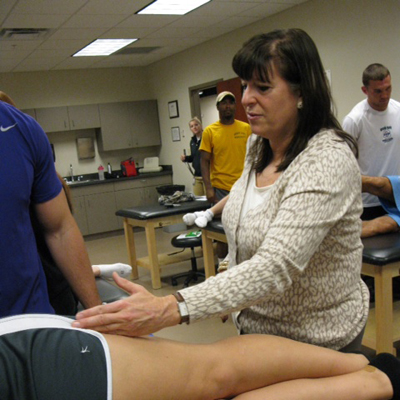May 1, 2017Double Duty

Some collegiate athletic trainers have little to no desire to work with athletic training students, which is understandable. After all, it’s a great deal of work and can take time away from direct patient care. However, many of us — myself included — find that work as a clinical preceptor is fun and tremendously rewarding.
That being said, it can be professionally challenging. One of the many challenges of managing this role is being able to comfortably balance our duties as an athletic trainer with our duties as a preceptor. This can manifest in several different situations, but I’ll illustrate two common ones below:
1. An acute injury: In the event of an acute injury, I think the dilemma for the athletic trainer/preceptor comes down to answering this question: “Do I do what is best for the athlete or what is best for the athletic training student?” Those outcomes might be the same, but sometimes, they are not.
In the event of an acute injury, I think the dilemma for the athletic trainer/preceptor comes down to answering this question: “Do I do what is best for the athlete or what is best for the athletic training student?”
For example, say you have an athletic training student covering a game with you when one of your athletes goes down with what appears to be a significant knee injury. Both you and the athletic training student go on the field to attend to the athlete. At this point, do you stand back and allow the student to calm the athlete and do the on-field assessment, or do you take over while the student observes?
While either scenario might be a valuable learning experience, I think your decision should rest on the skill level of the student. For a senior with strong clinical skills, this might be a great chance for them to utilize those skills in a real situation with you as a backup. It might even potentially serve as a type of capstone experience where the athletic training student can utilize assessment, critical thinking, and clinical decision-making skills.
However, for a first-semester junior, this scenario might be too much for them and potentially overwhelming. This student might instead benefit from observing how you handle the athlete, the on-field evaluation, your decision-making process, and follow-up care.
Now which outcome is best for the athlete in this example? I think we would all agree that having an experienced athletic trainer doing the evaluation and initial management is the best case. But if the athletic trainer can directly supervise the care by the student, the skills required are manageable for the student, and the athletic trainer can intervene if necessary, this can be a good experience for both the athletic training student and the athlete.
2. Routine taping: I’m sure many athletic trainers/preceptors have been faced with the situation where a young, eager athletic training student steps up to tape one of your athletes prior to practice or a game and does a less-than-perfect job. Maybe there are wrinkles that could potentially cause a blister, or perhaps it’s simply a tape job that provides less-than-optimal support. Do you allow the athlete to go out on the field, possibly risking injury, or do you remove the tape and do it over, potentially embarrassing the athletic training student in front of the athlete and their peers?
For me, this scenario always qualifies as a teachable moment. The safety of the athlete certainly has to take priority here, so you are going to need to re-do the taping. It’s possible to do so in a tactful way, though. I think it’s best to pull the athletic training student aside and tell them that you appreciate them taking initiative, but you can’t in good conscience allow the athlete to go on the field with a tape job that might not be as protective as it should. Then, without drawing attention to the situation, tell the athlete that you’re going to re-do what the athletic training student did. Trust me, the athlete was probably hoping this would happen. You can re-do the taping with the athletic training student present so they can see what they didn’t do well. This is also a good opportunity to offer to spend some time at a later date working with the athletic training student on taping skills.
Aside from the two situations I’ve presented here, there are surely others where you will need to strike that balance between athletic trainer and preceptor — situations where you ask yourself, “Do I provide the best care possible immediately, or do I allow the student to learn from this?” Each scenario is different in terms of injury, athlete, and athletic training student, so there is no universal right answer. But if you use good judgment, err on the side of patient care, and are respectful toward the feelings and self-confidence of your students, you should get it right.



